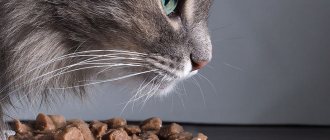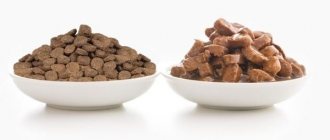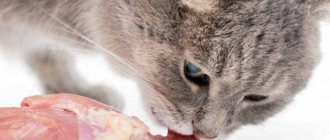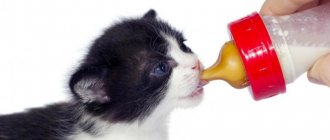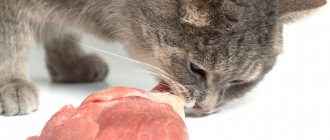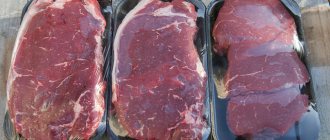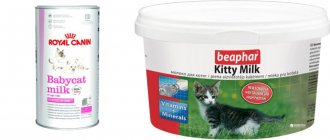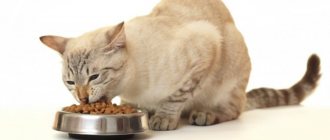Should I give my cat boiled or raw meat*? This is one of the most important issues when creating a so-called “natural” diet for your pet. And both options have their pros and cons, which we will discuss in this article.
Can cats eat raw meat?
The answer is clear: it is possible and necessary. It is obvious that for domestic cats living on the street, like their wild counterparts, no one prepares food for them; they consume rodents, mice and birds raw. At the same time, unlike many predators, they eat them immediately and mostly whole, without leaving the prey to decompose for more efficient absorption.
The cat's gastrointestinal tract is naturally designed to consume raw meat. The high acidity of gastric juice allows you to destroy pathogens contained in the carcass and dissolve raw bones. And the enzymes produced by the pancreas and other digestive organs, like the bacteria in the cat’s intestines, are adapted for the digestion of raw meat.
However, owners should understand that there is still a difference between a domestic cat living indoors and a wild or outdoor cat. So the acidity of the stomach, the composition and amount of bacteria and enzymes, directly depends on what the animal eats. If a cat has been eating industrial food for a long time, then it will be difficult for its body to digest raw meat and destroy the pathogenic organisms in it, many of which are dangerous not only for the cat, but also for humans.
Of course, a cat can be gradually transferred to raw meat, but such a transfer is not always necessary. You should not experiment if the cat is younger than 6 months/over 7 years old or if it has chronic diseases, especially those related to digestion. Most importantly, remember that the perfect is the enemy of the good. Does your cat thrive without raw meat? So there is no need to change anything.
What kind of meat can you give to a cat?
Cats are predators, and meat has been and remains their main food from time immemorial. This means that their digestive system is adapted for processing raw meat - under natural conditions, wild cats, and no one will boil it either. Therefore, veterinarians believe that raw meat can be given to cats, but only what kind?
Experts say that beef, lean lamb and horse meat, rabbit meat, as well as chicken and turkey meat are beneficial for pets. You can also give cats by-products - it’s not for nothing that they are included in many industrial foods.
Each type of meat has its own composition of nutrients that pets need. Red beef meat has very little fat, but is high in protein and iron. This product is least likely to cause allergic reactions in pets. Raw meat retains all the beneficial substances as much as possible, cats are attracted by the smell of food, and the structure of beef is fibrous but soft - optimal for the teeth of a home hunter. The veins that are found in beef are not a hindrance to the teeth: on the contrary, such food has a beneficial effect on the health of the teeth: in the process of chewing the meat, they self-clean.
Turkey is a record holder among other types of meat in terms of protein content - almost 50%! Turkey meat is easily digestible, quickly absorbed and suitable even for small kittens who still have a weak digestive system. Many owners have noticed that after adding turkey meat to their pet’s diet, their animals’ stools have returned to normal and they do not suffer from bloating.
Turkey meat contains many important substances. Vitamin A helps strengthen the immune system, E is a strong antioxidant. Turkey meat contains taurine, an essential amino acid for cats, which supports the cat’s cardiovascular system and ensures visual acuity. Turkey meat contains calcium and iron: the first element is necessary for strong bones and teeth, the second strengthens the cat’s nervous system.
The most popular and affordable type of meat is chicken. It has a delicate consistency, contains a lot of protein, and in extremely rare cases causes allergic reactions. White chicken breast meat contains a lot of protein and little fat; this product is considered dietary. Red contains many useful microelements, in particular iron, zinc, and vitamins.
Important!
Cats should not be given chicken skin, as it is difficult to digest, contains a lot of fat, as well as tubular bones, which can injure the esophagus and intestines.
Dry food and canned food for cats
If you do not have enough time or knowledge to keep your pet on a natural diet, you can give him ready-made food.
Their use greatly simplifies the process of feeding a cat, however, there are rules that must be followed so as not to harm the health of the animal. It is strictly not recommended to feed your pet cheap food that can be bought at any grocery store. They are made from extremely low quality ingredients and contain dyes and flavoring additives that are harmful to the cat’s health (long-term use of such foods leads to the development of urolithiasis). In addition, supplements are addictive, and in the future it will be difficult for you to switch your pet to normal, healthy food.
Buy professional food. They cost an order of magnitude more, but their price is quite justified. Such food has a balanced composition, is made from products of appropriate quality (usually meat and cereals), and does not contain dyes or flavoring additives. A wide range of products allows you to select food depending on the age, breed, and health status of the cat.
Ready-made food is divided into two types: dry and canned. Dry food is not recommended for kittens under 3 months of age. At the age of 3–7 months, your pet should buy special food for kittens. Otherwise, if the animal is healthy, there should be no problems with feeding dry food.
If you feed your cat dry food, make sure there is always fresh drinking water in the bowl.
Canned food has the same nutritional value as dry food, but is a little more expensive. It is believed that such food is digested somewhat better than dry food. They are recommended to be given to older animals who have problems with teeth and digestion, as well as during illness.
What kind of meat should you not feed?
But not all types of meat are healthy for pets. The following are prohibited for cats:
- pork;
- goose and duck meat;
- other fatty meats.
Pork is one of the fattiest types of meat, which, if consumed regularly, can lead to pancreatitis, chronic renal failure and cirrhosis of the liver in a cat. For some especially sensitive animals, even a small piece of raw pork can cause allergies, intestinal upset and other health problems.
In addition, it is raw pork that is most often infected with tapeworm - a dangerous intestinal parasite, trichinella and other helminths that survive even when the meat is cooked.
Duck and goose are also types of meat that are too fatty for a cat, so it is not recommended to give them to your pet either raw or heat-treated.
Raw or boiled? Pros and cons
However, boiled meat is digested worse by cats, including kittens, than raw meat. In this case, you can resort to freezing the chicken meat. Prolonged freezing as well as heat treatment kills parasites - and before giving it to the cat for consumption, pour boiling water over it. It is better to freeze by dividing the chicken into small single portions. Store each portion in a separate bag. Take out the bag with a portion of meat before feeding, defrost it and give it to the kitten. It is better to serve raw chicken meat cut into small pieces rather than as minced meat. After all, raw minced chicken is quite liquid, and it will be uncomfortable for the kitten to eat it. You can defrost meat in a microwave or microwave oven, then the meat will be additionally heat-treated.
How to properly feed a cat meat
Natural predators do not feed only on animal fillets. They eat the prey whole - with small bones and entrails - by-products. Therefore, you can (and even need to!) give your cat not only tenderloin, but also offal, which contains many nutrients and beneficial substances. Thus, the liver contains vitamin A - it is not synthesized in the body of cats, so it must be supplied there with food. Cartilage and tendons are also useful, but feeding only fillet can lead to digestive problems and vitamin deficiency.
You can give your furry pet raw meat at least every day, preferably in the morning, then absorption will be better. Do not give large pieces - your pet may swallow it without chewing. Optimally, cut the meat into 1.5*1.5 cm cubes. You can prepare a hearty and healthy dish for your pet by mixing finely chopped meat (3 parts) with vegetable puree (1 part), made from zucchini, cabbage and carrots, boiled on a couple. Add 1 tbsp. a spoonful of olive oil - and a healthy breakfast for your cat is ready.
Important!
It is not recommended to give minced meat to cats - it contains a lot of fat, and due to its consistency it is not digested properly. You should not give bones either - they clog the intestinal lumen, can injure the stomach and intestines, and lead to death in a matter of hours due to internal bleeding.
By-products (liver, heart, lung) are recommended to be given no more than 200 g per week. However, not all cats digest them easily, so despite their beneficial composition, they should not be given frequently.
Cat feeding regimen. Feed requirement
Kittens are fed 4–5 times a day, giving food in small portions. It is recommended to feed adult cats 2-3 times a day. If you feed your pet natural food or canned food, do not leave leftover food in the bowl. Dry food can be poured several times a day or the daily amount can be immediately placed in a bowl so that the cat eats it when it gets hungry (the latter option is not suitable for pets suffering from gluttony).
The amount of food should be such as to satisfy the animal's need for basic nutrients (proteins, fats and carbohydrates). Experts recommend calculating the daily food requirement depending on the weight of the animal (5% of the body weight of an adult cat and 10% of the body weight of a kitten, that is, an adult cat weighing 4 kg should receive 200 g of food daily).
With a natural diet, at least half of the total amount of food should be meat or fish, the rest should be fermented milk products. If you feed your pet with ready-made food, follow the recommended daily amount indicated on the packaging, taking into account individual characteristics.
Can a kitten eat raw beef?
For kittens, the toughness of the meat is quite critical. The fibrous red meat of a large animal is very different from the meat of a small mouse - nature does not provide such nutrition, so the kitten’s jaws and teeth are simply not able to cope with such a tough food.
If owners give beef to a kitten, they should grind it thoroughly, for example, by grinding it through a meat grinder. You should be sensitive to the quality of meat and buy it only in stores or markets where there is proper veterinary control.
You can boil the meat, because such a product is easier to digest, but you should understand that cooking destroys many useful substances that are sensitive to heat treatment, some of which also go into the water. Some owners, not too sure whether kittens can be given raw beef, buy their pets baby food, which is homogenized boiled meat.
This is an excellent solution for the first feeding of a small kitten, but for older babies it is better to give rougher food. In addition, food created for humans is not completely complete for carnivores.
What about salmonella in raw chicken?
In 2010, 900 samples of Russian chicken were sent for research to the University of Georgia in the USA, and salmonella was found in 31% of the products (that is, in a third!). Most often, the bacterium attacked poultry from factories in the Northwestern and Southern regions of Russia. Abroad, feeding cats raw chicken is much safer: for example, in Sweden and Denmark there is no salmonella in poultry at all, and in the USA it is found in slightly more than 3.8% of samples (there was the same 30% rate of chicken infection with salmonella, but it was reduced with the help of a special state program). And in our country, the percentage of infected chickens, of course, decreases over time, but the risk still remains.
The healthiest meat
To keep your furry pet healthy, it is recommended to feed it raw meat. It has a number of useful properties:
- has all the amino acids and proteins necessary for the body to function properly;
- ensures the functioning of internal organs;
- easily digested in the stomach;
- the cat is less likely to get gastrointestinal diseases.
Fried or smoked meat is not allowed. These products can irritate the digestive system and cause severe gastrointestinal diseases. Substances contained in fried foods and smoked foods contribute to the occurrence of liver pathology. If a cat suffers from a “weakness” of the pancreas, then due to poor quality food, diseases of this organ may appear.
Cold meat just taken out of the freezer can make your pet sick. It is better if it is at room temperature - the risk of colds will be reduced to zero.
One of the important issues of concern to those who keep their pets on a raw diet is the safe handling of food.
And we are talking, first of all, about protecting humans, because many microorganisms that are dangerous to them do not cause any diseases in cats. Where do pathogenic bacteria come from, why do dark spots appear on frozen meat, how to store cat food and how to protect yourself and your pet? The answers to these questions will help you not be afraid to feed your cats correctly - raw animal products. Where do bacteria come from
? Various bacteria can be found everywhere, but not all of them are pathogenic, causing diseases in humans or animals. Microorganisms remain on the surface of vegetables and fruits after harvest, molds and their by-products can appear in grains during the wet season or improper storage, seafood can become contaminated by sewage, as well as bacteria and toxins present in seawater. Atypical microflora can get into milk, eggs, meat, and poultry due to improper housekeeping, the use of low-quality feed, and non-compliance with sanitary and veterinary standards.
In addition, food contamination can also occur during processing or preparation for sale. Faulty equipment, lack of disinfection, incorrect or irregular use of cleaning products, the presence of rodents and insects, etc. may be to blame.
Infection is possible in retail outlets due to non-compliance with temperature conditions and rules of the commodity neighborhood. But even if the product remains clean at all stages, from production to sale, this does not protect it from contamination after purchase.
The greatest danger from the point of view of bacterial contamination are places of unauthorized trade, private farmsteads, and spontaneous markets. In official retail outlets that comply with the established rules of storage and trade and have the necessary certificates for products, there are significantly fewer risks. There are even fewer of them where only frozen foods are sold.
Thus, it is better for a cat owner to choose not fresh meat from a local farmer, domestic chicken from the market or live fish, but products that have passed certification and are deep-frozen immediately after slaughter or catch.
Processing, storage and defrosting
The microworld is huge and diverse. Some bacteria die at very low temperatures, some go to sleep, and some simply reduce their reproduction rate. Some microorganisms cause spoilage of products, changing their consistency, smell and taste, but there are also those that do not manifest themselves externally and are pathogenic. Bacteria will grow anywhere there is access to water and nutrients. They reproduce quickly, and under certain conditions they can double their numbers in just 20 minutes.
If the product was not initially contaminated with harmful microorganisms, then constant storage at a temperature of minus 18 degrees automatically makes it safe. But since it is impossible to know in advance whether there were any bacteria on the food before freezing, you should always follow safety rules during processing and storage.
For the active growth of harmful microflora, temperature, humidity and area are important. The colder the product, the lower its humidity, the larger the piece, the slower bacteria will multiply. Therefore, if you need to divide purchased frozen meat into portions, it is better not to wait until it is completely defrosted. This method may not be the easiest, but it will preserve the best possible quality and, importantly, moisture.
Freezing does not affect the nutritional value of products, but they should still be stored correctly, preventing air from entering. This can be a plastic bag or container with a tightly closed lid. Air entering the surface of the product in the freezer causes cold burn, and brown or gray spots appear on the meat. In this case, the meat does not spoil, but dries out, and the larger the area of contact with air, the more moisture it will lose during storage.
From a safety point of view, not only the freezing and storage process is important, but also the defrosting conditions.
Do not defrost open or warm. At a certain temperature, microflora will already actively grow on the surface of the product, while inside it will still remain icy. For the same reasons, portion packaging should be made as flat as possible. And you should never defrost in the microwave, especially meat bones. Under these conditions, they can begin to cook long before the entire piece has thawed, and cooked bones are deadly to a cat. The ideal way is to defrost gradually in the refrigerator. If you need to defrost quickly, you can immerse the meat in a sealed package in cold water and change it as it cools. Not everything is as dangerous as it seems.
Harmful microorganisms that everyone knows about are salmonella and E. coli. Perhaps someone will remember campylobacter and clostridia. A person encounters these bacteria all the time, but even once they enter the body, they do not always cause disease. Firstly, for their growth and development, a combination of several conditions is necessary, and secondly, the body provides some kind of protection against the penetration of pathogenic flora. And, perhaps, one of the strongest defenses is possessed by the predator’s body, because its natural food is raw meat without any processing.
One of the protective factors is the high acidity of gastric juice. It allows you to successfully and quickly dissolve raw meat and bones, and it also effectively destroys bacteria. Including salmonella, E. coli, campylobacter and clostridia. Digestion adapts to the type of food, so the concentration of acid is higher in the stomachs of those cats that are kept on natural raw meat diets. Consequently, they have higher protection against pathogenic microorganisms compared to those who eat dry industrial feed.
The second protective factor is the length of the digestive tract. In carnivores it is the shortest, in omnivores it is of medium length, and the longest in herbivores. The time for complete digestion depends on the length. While herbivores can have plant food in their gastrointestinal tract for up to five days, a cat or dog completely digests the meat they eat in a maximum of 12 hours.
In order for a pathogenic bacterium entering the body to cause any disorder, it needs certain conditions and time to reproduce.
The peculiarities of the digestive tract of predators, which include cats, do not allow such conditions and time. Conclusions
All the described rules for handling raw meat relate more to human safety. If a cat is kept on a natural diet, it is much more protected from harmful microflora than its owner. However, cat products must be purchased only in official retail outlets and have the appropriate certificates and certificates. Meat and fish should be stored at a temperature of minus 18 in a tightly closed container, which ensures safety without loss of quality. Ideal conditions for defrosting are a refrigerator compartment with a temperature of plus 4-6 degrees. It is enough for the owner to observe basic rules of personal hygiene in order to protect himself from pathogenic microflora; a healthy cat will be protected by its body.
Meat and meat products in a cat's diet
Any lean meat is suitable for feeding cats - beef, veal, turkey, rabbit, chicken. For small kittens, minced meat made from a mixture of turkey and veal is ideal. Deciding whether it is possible to give your cat raw meat or whether it is better to boil it a little first depends on the animal’s preferences - some people do not like boiled food.
Meat by-products (chicken stomachs and hearts), previously well washed and deveined, are also useful for cats. Liver is also good for them, but you shouldn’t get too carried away with it - raw liver weakens you, while boiled liver, on the contrary, strengthens you. Therefore, pre-frozen liver can be given no more than twice a week.
How to give: the best recipes
Cat owners recommend preparing the following simple chicken dishes for natural-fed pets:
- Chicken with vegetables. The breast is boiled and chopped. Add steamed broccoli and carrots in equal proportions. Then a small amount of fresh broth is introduced.
- Liver with garnish. Finely boil and chop 400 g of offal with the addition of 2 tbsp. l. olive or sunflower oil. Add 200 g of steamed oatmeal and 50 g of steamed green peas.
- Kidneys in sauce. Boil and chop 200 g of chicken kidneys. Add 4 tbsp. l. prepared oatmeal and ¼ cup grated carrots. Melted butter of medium fat content - 30 g is poured on top. Then 70 ml of yogurt without additives is added.
- Nutritious breakfast. Boil 70 g of rice. It is better to use unrefined, as it improves intestinal motility. Combine 1 boiled chicken egg in one plate, 1 tbsp. l. chopped carrots and boiled green beans and 20 g of chopped chicken fillet. 3 tsp is introduced. olive fruit oils.
If your cat previously ate exclusively dry food, raw chicken may not be of interest to her. Veterinarians advise boiling it and adding treats that your pet loves.
For babies and older cats, veterinarians recommend placing cooked food in a blender to simplify digestion and prevent constipation. It is not enough for cats to eat meat in its pure form; the menu must be supplemented with sources of carbohydrates and fiber - bran, vegetables or fruits.
